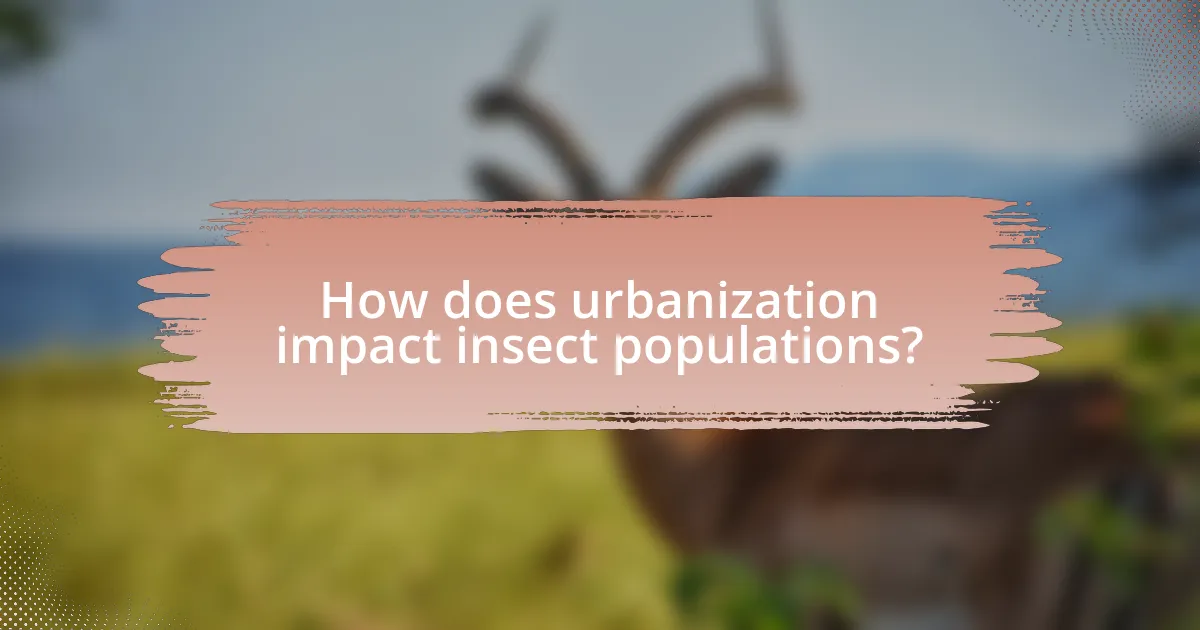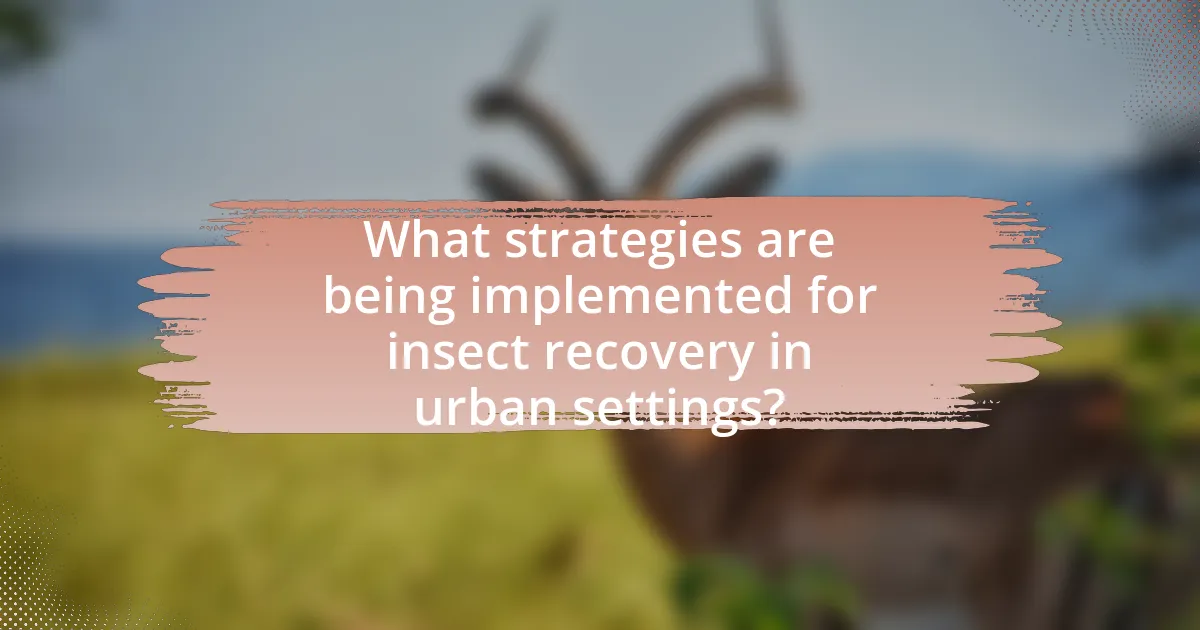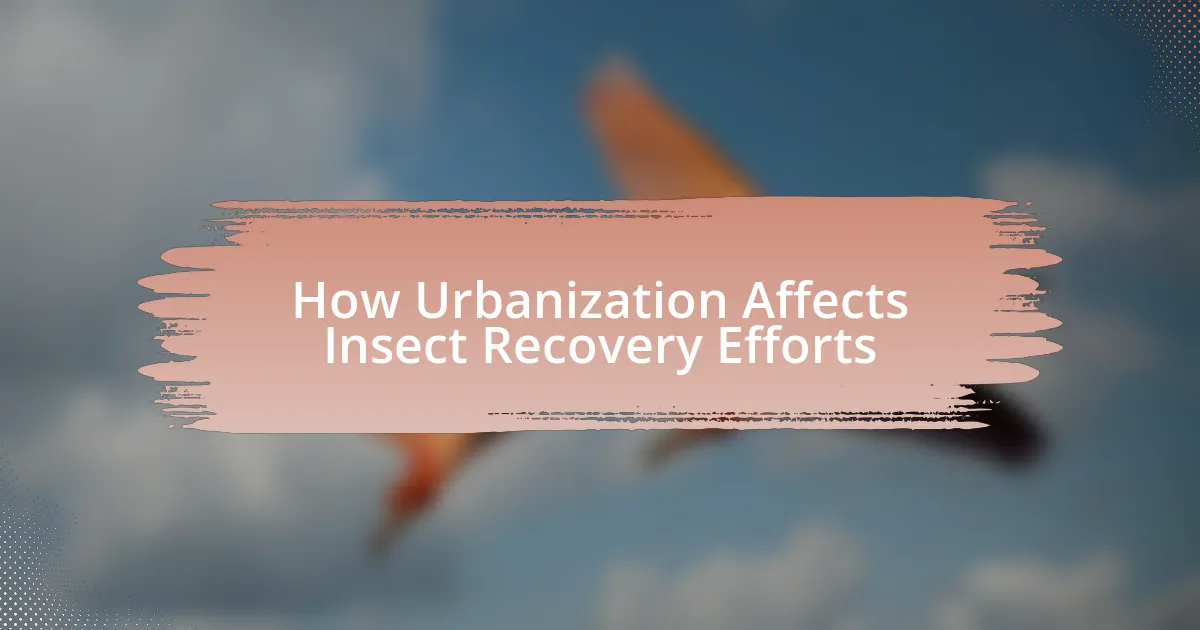Urbanization significantly impacts insect populations by altering habitats, leading to biodiversity loss and ecological imbalance. The expansion of cities results in habitat fragmentation, increased pollution, and pesticide use, which threaten insect survival and diversity. Research indicates that urban areas can experience a decline in insect species by up to 50%, affecting essential ecosystem services such as pollination and pest control. Strategies for recovery include creating green spaces, promoting biodiversity-friendly practices, and engaging communities in conservation efforts, all of which are crucial for mitigating the adverse effects of urbanization on insect populations. Understanding these dynamics is vital for effective urban planning and enhancing urban biodiversity.

How does urbanization impact insect populations?
Urbanization significantly reduces insect populations by altering their habitats and disrupting ecological balance. As cities expand, natural landscapes are replaced with impervious surfaces, leading to habitat loss and fragmentation, which diminishes food sources and breeding sites for insects. Research indicates that urban areas often experience a decline in biodiversity; for example, a study published in the journal “Biological Conservation” found that urbanization can decrease insect diversity by up to 50% in some regions. Additionally, increased pollution and pesticide use in urban settings further threaten insect survival, contributing to population declines.
What are the primary effects of urbanization on insect habitats?
Urbanization primarily affects insect habitats by reducing biodiversity, altering microclimates, and fragmenting ecosystems. The conversion of natural landscapes into urban areas leads to habitat loss, which significantly decreases the variety of insect species present. For instance, studies have shown that urban areas can have up to 50% fewer insect species compared to rural environments due to habitat destruction and pollution. Additionally, urbanization creates heat islands, which can change temperature and humidity levels, further impacting insect survival and reproduction. Fragmentation of habitats isolates insect populations, making it difficult for them to migrate, find mates, or access resources, ultimately threatening their long-term viability.
How does habitat fragmentation influence insect diversity?
Habitat fragmentation negatively influences insect diversity by isolating populations and reducing available habitats. This isolation leads to decreased gene flow, which can result in inbreeding and reduced resilience to environmental changes. Studies indicate that fragmented habitats often support fewer species due to limited resources and increased edge effects, which can alter microclimates and predation pressures. For instance, a meta-analysis published in “Ecological Applications” by Fahrig (2017) found that habitat fragmentation consistently decreases species richness across various taxa, including insects, highlighting the critical impact of habitat connectivity on biodiversity.
What role does pollution play in urban insect survival?
Pollution significantly impacts urban insect survival by altering their habitats and food sources. Insects are sensitive to pollutants such as pesticides, heavy metals, and particulate matter, which can lead to decreased populations and biodiversity. For instance, studies have shown that urban areas with high levels of air pollution often experience reduced insect diversity and abundance, as pollutants can disrupt reproductive processes and impair immune responses. Additionally, contaminated water sources can affect larval development in aquatic insects, further diminishing their survival rates.
Why is understanding insect recovery important in urban areas?
Understanding insect recovery is important in urban areas because it directly impacts biodiversity, ecosystem services, and urban resilience. Urbanization often leads to habitat loss and fragmentation, which can severely affect insect populations. Research indicates that urban green spaces can support insect diversity, with studies showing that cities with more vegetation have higher insect abundance and diversity. For instance, a study published in “Ecological Applications” by McKinney (2002) highlights that urban areas can serve as refuges for certain insect species, thereby contributing to overall ecological health. Recognizing the factors that facilitate insect recovery in these environments is crucial for effective urban planning and conservation strategies.
How do insects contribute to urban ecosystems?
Insects contribute to urban ecosystems by providing essential services such as pollination, decomposition, and pest control. Pollinators like bees and butterflies enhance urban biodiversity by facilitating the reproduction of flowering plants, which is crucial for food production and ecosystem health. Decomposers, including ants and beetles, break down organic matter, recycling nutrients back into the soil, which supports plant growth. Additionally, predatory insects help manage pest populations, reducing the need for chemical pesticides and promoting a healthier urban environment. Studies indicate that urban green spaces with diverse insect populations can improve overall ecosystem resilience and functionality, highlighting the importance of insects in maintaining urban ecological balance.
What are the implications of declining insect populations for urban biodiversity?
Declining insect populations significantly threaten urban biodiversity by disrupting food webs and pollination processes. Insects serve as crucial pollinators for many plants, and their decline can lead to reduced plant reproduction and diversity, ultimately affecting the entire urban ecosystem. For instance, studies indicate that urban areas with lower insect diversity experience diminished plant growth and fewer flowering species, which can lead to a less resilient urban environment. Additionally, the loss of insects impacts other wildlife, such as birds and small mammals, that rely on insects as a primary food source, further diminishing urban biodiversity.

What strategies are being implemented for insect recovery in urban settings?
Strategies for insect recovery in urban settings include creating green spaces, implementing biodiversity-friendly landscaping, and promoting community engagement in conservation efforts. Urban planners and ecologists are increasingly designing parks, green roofs, and community gardens to provide habitats for various insect species. Research indicates that urban green spaces can support higher insect diversity, with studies showing that cities with more vegetation have a greater abundance of pollinators. Additionally, initiatives that educate residents about the importance of insects and encourage practices such as planting native flora contribute to recovery efforts. These strategies are essential for mitigating the impacts of urbanization on insect populations.
How can urban planning support insect recovery efforts?
Urban planning can support insect recovery efforts by integrating green spaces, promoting biodiversity, and implementing sustainable land-use practices. By designing urban environments that include parks, gardens, and green roofs, cities can provide habitats for various insect species, which are essential for pollination and ecosystem health. Research indicates that urban green spaces can increase insect diversity and abundance; for instance, a study published in “Ecological Applications” found that urban parks can support higher levels of insect diversity compared to surrounding urban areas. Additionally, urban planning can incorporate native plant species in landscaping, which attract and sustain local insect populations, further enhancing biodiversity.
What are the benefits of creating green spaces for insects?
Creating green spaces benefits insects by providing essential habitats, food sources, and breeding grounds. These areas support biodiversity, allowing various insect species to thrive, which is crucial for pollination and ecosystem balance. Research indicates that urban green spaces can increase insect populations by up to 50%, enhancing local ecosystems and agricultural productivity. Additionally, green spaces help mitigate the effects of urbanization, offering refuge from habitat loss and fragmentation, thereby promoting insect recovery and resilience in urban environments.
How can community involvement enhance insect recovery initiatives?
Community involvement can enhance insect recovery initiatives by fostering local stewardship and increasing public awareness of insect conservation. Engaged communities can participate in habitat restoration projects, such as planting native vegetation that supports insect populations. For instance, studies have shown that urban gardens and green spaces can significantly boost local biodiversity, including insect species. Additionally, community-led monitoring programs can provide valuable data on insect populations, helping researchers identify trends and implement effective recovery strategies. This collaborative approach not only empowers residents but also creates a sense of ownership over local ecosystems, leading to sustained conservation efforts.
What role do conservation programs play in urban insect recovery?
Conservation programs play a crucial role in urban insect recovery by creating habitats and promoting biodiversity within city environments. These programs often involve the restoration of green spaces, implementation of pollinator gardens, and the reduction of pesticide use, which collectively enhance the availability of resources for insects. For instance, studies have shown that urban areas with well-managed green spaces can support higher insect populations, as they provide essential food sources and nesting sites. Additionally, conservation initiatives often include community engagement and education, which raise awareness about the importance of insects in ecosystems, further supporting recovery efforts.
Which organizations are leading urban insect recovery efforts?
Organizations leading urban insect recovery efforts include the Xerces Society for Invertebrate Conservation, which focuses on protecting pollinators and other invertebrates through habitat restoration and advocacy. Additionally, the Urban Ecology Lab at the University of Toronto conducts research on urban biodiversity, including insect populations, and promotes strategies for enhancing urban habitats. The National Wildlife Federation also engages in initiatives to create pollinator-friendly spaces in urban areas, supporting insect recovery through community involvement and education. These organizations are pivotal in addressing the challenges urbanization poses to insect populations by implementing conservation strategies and raising awareness.
How effective are current conservation strategies in urban environments?
Current conservation strategies in urban environments are moderately effective, with varying success depending on specific approaches and local conditions. Research indicates that strategies such as green roofs, urban gardens, and habitat restoration can enhance biodiversity and support insect populations, which are crucial for ecosystem services. For instance, a study published in the journal “Urban Ecology” found that urban green spaces can increase insect diversity by up to 30% compared to areas with minimal vegetation. However, challenges such as habitat fragmentation and pollution continue to hinder overall effectiveness, necessitating more integrated and adaptive management practices to improve outcomes for insect recovery in urban settings.

What challenges do urbanization and recovery efforts face?
Urbanization and recovery efforts face significant challenges, primarily habitat loss and fragmentation. As urban areas expand, natural habitats are destroyed or altered, leading to decreased biodiversity and making it difficult for insect populations to thrive. For instance, a study published in the journal “Biological Conservation” found that urbanization can reduce insect diversity by up to 75% in affected areas. Additionally, pollution from urban environments further exacerbates the decline of insect species, as many are sensitive to changes in their chemical environment. These factors collectively hinder recovery efforts aimed at restoring insect populations, making it crucial to address urban planning and environmental policies to mitigate these impacts.
How does climate change intersect with urbanization and insect recovery?
Climate change significantly impacts urbanization and insect recovery by altering habitats and ecosystems. Urban areas often experience increased temperatures and altered precipitation patterns due to climate change, which can lead to habitat loss and fragmentation for insects. For instance, studies show that urban heat islands can exacerbate the decline of insect populations by creating inhospitable environments. Additionally, urbanization itself contributes to biodiversity loss, making it harder for insects to recover. Research indicates that urban green spaces can mitigate some negative effects of climate change, providing essential habitats for insects. However, the effectiveness of these spaces is often limited by ongoing urban development and climate-related stressors, which can hinder insect recovery efforts.
What specific climate-related threats do urban insects encounter?
Urban insects encounter specific climate-related threats such as increased temperatures, altered precipitation patterns, and habitat fragmentation. Increased temperatures can lead to heat stress and reduced survival rates, while altered precipitation patterns can disrupt food availability and breeding cycles. Habitat fragmentation, often exacerbated by urban development, limits the movement and genetic diversity of insect populations, making them more vulnerable to extinction. Studies indicate that urban heat islands can raise local temperatures by up to 5 degrees Celsius, further stressing insect communities.
How can recovery efforts adapt to changing climate conditions?
Recovery efforts can adapt to changing climate conditions by implementing flexible management strategies that account for climate variability. These strategies include monitoring environmental changes, utilizing climate-resilient species in restoration projects, and adjusting timelines for recovery based on climate forecasts. For instance, studies have shown that insect populations are sensitive to temperature and precipitation changes, which can affect their recovery rates. By integrating climate data into recovery planning, such as using predictive models, efforts can be more effectively aligned with the ecological needs of species affected by urbanization and climate change.
What are the common misconceptions about urban insects and their recovery?
Common misconceptions about urban insects and their recovery include the belief that urban environments are inhospitable to insect populations and that urbanization leads to a permanent decline in insect diversity. In reality, many urban areas can support diverse insect communities due to the presence of green spaces, gardens, and parks that provide essential habitats. Research indicates that certain insect species can thrive in urban settings, adapting to the modified landscapes. For example, studies have shown that urban areas can harbor significant populations of pollinators, such as bees, which are crucial for ecosystem health. Additionally, the notion that urbanization irreversibly harms insect recovery is misleading; many species can rebound when suitable habitats are restored or created, demonstrating resilience in the face of urban development.
Why is it important to educate the public about urban insects?
Educating the public about urban insects is crucial for fostering biodiversity and promoting ecological balance in urban environments. Urban insects play significant roles in pollination, decomposition, and pest control, which are essential for maintaining healthy ecosystems. For instance, studies show that urban areas can support diverse insect populations, which contribute to the resilience of urban green spaces. By raising awareness, communities can better appreciate the ecological functions of these insects, leading to more informed decisions regarding urban planning and pest management. Furthermore, education can mitigate negative perceptions of insects, reducing unnecessary extermination and promoting coexistence, which is vital for sustaining urban biodiversity.
How can misinformation hinder recovery efforts?
Misinformation can significantly hinder recovery efforts by spreading false narratives that misguide public perception and action. For instance, inaccurate information about the effectiveness of certain recovery strategies can lead to the misallocation of resources, as stakeholders may prioritize ineffective methods over scientifically supported ones. Additionally, misinformation can create public distrust in recovery initiatives, resulting in reduced community participation and support, which are crucial for successful recovery. Studies have shown that misinformation during ecological crises can delay recovery timelines and exacerbate the impacts of urbanization on insect populations, as communities may fail to implement necessary conservation measures based on erroneous beliefs.
What practical steps can individuals take to support urban insect recovery?
Individuals can support urban insect recovery by creating diverse habitats, such as planting native flowers and reducing pesticide use. Diverse habitats provide essential food sources and nesting sites for various insect species, which are crucial for their survival. Research indicates that urban green spaces with native plants can increase local insect populations by up to 50%, enhancing biodiversity. Additionally, minimizing pesticide application helps protect beneficial insects, as studies show that pesticides can significantly reduce insect populations and disrupt ecosystems. By implementing these practical steps, individuals can contribute to the recovery of urban insect populations effectively.


